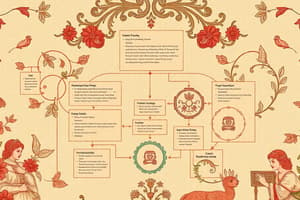Podcast
Questions and Answers
What is the primary purpose of a User Interface in a system?
What is the primary purpose of a User Interface in a system?
- To manage backend processes
- To ensure system security
- To store user data securely
- To facilitate interaction between humans and machines (correct)
Which of the following best describes the impact of poor UI design?
Which of the following best describes the impact of poor UI design?
- It improves overall application performance.
- It makes the application more aesthetically pleasing.
- It can lead to user frustration and negative perceptions. (correct)
- It has no effect on user experience.
What is an essential function provided by User Interfaces?
What is an essential function provided by User Interfaces?
- Conducting backend calculations
- Manipulating user data without input
- Allowing input from users to manipulate a system (correct)
- Storing system logs for future access
Which statement about User Interfaces is true?
Which statement about User Interfaces is true?
How do User Interfaces indicate the effects of user manipulation?
How do User Interfaces indicate the effects of user manipulation?
What is NOT typically included in the screen description of a user interface mock-up?
What is NOT typically included in the screen description of a user interface mock-up?
Which element defines a specific condition that needs to be met for a use case to execute?
Which element defines a specific condition that needs to be met for a use case to execute?
What is the main purpose of a use case in user interface design?
What is the main purpose of a use case in user interface design?
What does the term 'Basic Flow' refer to in a use case?
What does the term 'Basic Flow' refer to in a use case?
What is a key characteristic of a 'Trigger' in a use case?
What is a key characteristic of a 'Trigger' in a use case?
Which of the following best describes 'Validation' in the context of screen design?
Which of the following best describes 'Validation' in the context of screen design?
Which of the following is NOT a part of the UI Style?
Which of the following is NOT a part of the UI Style?
Which of the following roles is defined as an 'Actor' in a use case?
Which of the following roles is defined as an 'Actor' in a use case?
Which aspect emphasizes the ability of a system to quickly adapt to future changes without significant redesign?
Which aspect emphasizes the ability of a system to quickly adapt to future changes without significant redesign?
What is the desired characteristic of response time in system performance constraints?
What is the desired characteristic of response time in system performance constraints?
Reliability in a system is primarily specified using which metric?
Reliability in a system is primarily specified using which metric?
Which of the following best describes reusability in software design?
Which of the following best describes reusability in software design?
What does utilization refer to in specifying system performance constraints?
What does utilization refer to in specifying system performance constraints?
In terms of system availability, what does it mean when a server is available during standard working hours?
In terms of system availability, what does it mean when a server is available during standard working hours?
Throughput in system performance refers to which of the following?
Throughput in system performance refers to which of the following?
Which performance constraint might require limiting bandwidth usage?
Which performance constraint might require limiting bandwidth usage?
Flashcards are hidden until you start studying
Study Notes
Use Case Diagram
- Illustrates system functions and the interactions with actors.
Workflow
- Represents the sequence of processes and tasks within the system.
Functional Requirements
- Comprises User Interface and functional/business aspects.
User Interface Requirements
- Interaction space between users and machines; crucial for usability.
- Often referred to as the system's front-end.
- Functions include:
- Input: Enables user manipulation.
- Output: Shows results of user actions.
- Poor UI design can negatively impact first impressions.
Mock-up Screen Requirements
- Includes prototype and screen descriptions:
- Field names, control types, data types, default values.
- Attributes: mandatory, editable, max length, validation, etc.
Use Case/Function Study Overview
- Purpose: Summarizes the use case concept.
- Actor: Entity interacting with the use case.
- Pre-condition: System state before use case initiation.
- Trigger: Event that launches the use case.
- Basic Flow: Expected actions in an ideal scenario.
- Alternative Flow: Actions taken when issues arise.
- Post-condition: Possible system states after completion.
- Business Rules: Constraints guiding business processes.
Example Use Case: Client Creation
- Purpose: Add a new client to the system.
- Actor: Practice Business User (Manager, Administrative, or Sales).
- Pre-condition: User must log in with appropriate permissions.
- Trigger: User selects the Client Creation option from the menu.
Quality and Performance Constraints
- Maintainability and Enhancement: Future adaptability with anticipated changes; no new functional requirements should be added.
- Reusability: Ability to reuse code segments for new functions, minimizing implementation time.
- Reliability: Measured by mean time to failure; uptime need to exceed specified limits (e.g., ≤5 minutes downtime).
Performance Specifications
- Response Time: Fast computation time is preferred.
- Throughput: Measures transactions processed per unit of time (e.g., 1,000 transactions/sec).
- Utilization: Specifies resource consumption limits (e.g., ≤20MBPS bandwidth usage).
Design Constraints
- Availability: Indicates the operational hours of the system (e.g., 9 AM to 5 PM).
Studying That Suits You
Use AI to generate personalized quizzes and flashcards to suit your learning preferences.




